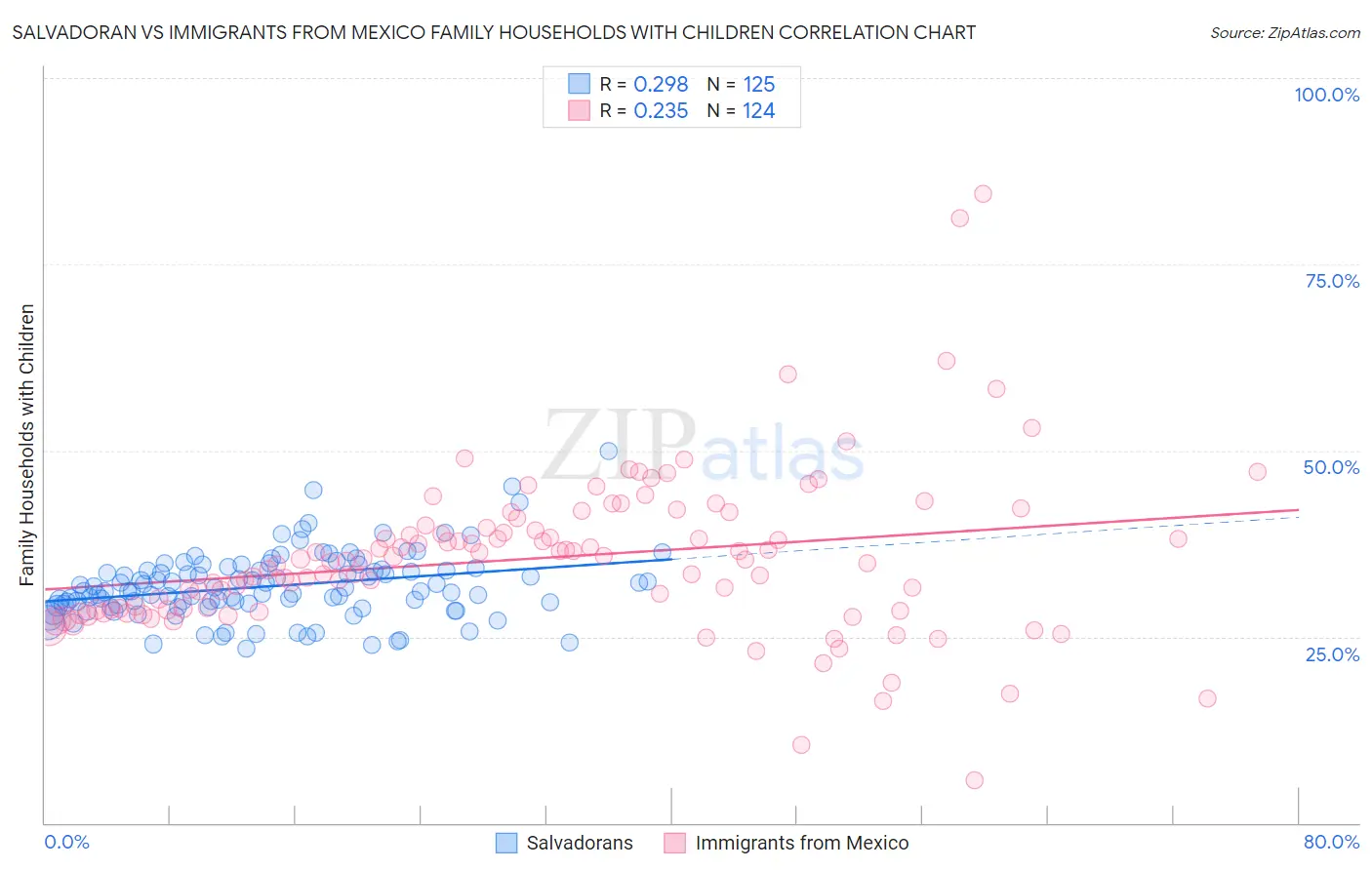Salvadoran vs Immigrants from Mexico Family Households with Children
COMPARE
Salvadoran
Immigrants from Mexico
Family Households with Children
Family Households with Children Comparison
Salvadorans
Immigrants from Mexico
29.9%
FAMILY HOUSEHOLDS WITH CHILDREN
100.0/ 100
METRIC RATING
18th/ 347
METRIC RANK
31.6%
FAMILY HOUSEHOLDS WITH CHILDREN
100.0/ 100
METRIC RATING
3rd/ 347
METRIC RANK
Salvadoran vs Immigrants from Mexico Family Households with Children Correlation Chart
The statistical analysis conducted on geographies consisting of 398,611,011 people shows a weak positive correlation between the proportion of Salvadorans and percentage of family households with children in the United States with a correlation coefficient (R) of 0.298 and weighted average of 29.9%. Similarly, the statistical analysis conducted on geographies consisting of 513,226,445 people shows a weak positive correlation between the proportion of Immigrants from Mexico and percentage of family households with children in the United States with a correlation coefficient (R) of 0.235 and weighted average of 31.6%, a difference of 5.9%.

Family Households with Children Correlation Summary
| Measurement | Salvadoran | Immigrants from Mexico |
| Minimum | 23.4% | 5.8% |
| Maximum | 49.9% | 84.4% |
| Range | 26.5% | 78.7% |
| Mean | 31.8% | 35.6% |
| Median | 31.1% | 35.3% |
| Interquartile 25% (IQ1) | 29.2% | 28.6% |
| Interquartile 75% (IQ3) | 34.0% | 39.8% |
| Interquartile Range (IQR) | 4.8% | 11.2% |
| Standard Deviation (Sample) | 4.5% | 10.9% |
| Standard Deviation (Population) | 4.5% | 10.8% |
Demographics Similar to Salvadorans and Immigrants from Mexico by Family Households with Children
In terms of family households with children, the demographic groups most similar to Salvadorans are Alaska Native (29.9%, a difference of 0.040%), Immigrants from El Salvador (29.8%, a difference of 0.070%), Hispanic or Latino (29.9%, a difference of 0.19%), Immigrants from Afghanistan (30.0%, a difference of 0.57%), and Immigrants from South Central Asia (30.0%, a difference of 0.60%). Similarly, the demographic groups most similar to Immigrants from Mexico are Mexican (31.4%, a difference of 0.78%), Tongan (31.2%, a difference of 1.2%), Immigrants from India (31.0%, a difference of 1.8%), Immigrants from Central America (31.0%, a difference of 2.1%), and Yakama (30.8%, a difference of 2.7%).
| Demographics | Rating | Rank | Family Households with Children |
| Yup'ik | 100 /100 | #1 | Exceptional 37.0% |
| Inupiat | 100 /100 | #2 | Exceptional 32.8% |
| Immigrants | Mexico | 100.0 /100 | #3 | Exceptional 31.6% |
| Mexicans | 100.0 /100 | #4 | Exceptional 31.4% |
| Tongans | 100.0 /100 | #5 | Exceptional 31.2% |
| Immigrants | India | 100.0 /100 | #6 | Exceptional 31.0% |
| Immigrants | Central America | 100.0 /100 | #7 | Exceptional 31.0% |
| Yakama | 100.0 /100 | #8 | Exceptional 30.8% |
| Thais | 100.0 /100 | #9 | Exceptional 30.6% |
| Immigrants | Fiji | 100.0 /100 | #10 | Exceptional 30.5% |
| Nepalese | 100.0 /100 | #11 | Exceptional 30.5% |
| Immigrants | Pakistan | 100.0 /100 | #12 | Exceptional 30.2% |
| Afghans | 100.0 /100 | #13 | Exceptional 30.2% |
| Bangladeshis | 100.0 /100 | #14 | Exceptional 30.1% |
| Immigrants | South Central Asia | 100.0 /100 | #15 | Exceptional 30.0% |
| Immigrants | Afghanistan | 100.0 /100 | #16 | Exceptional 30.0% |
| Hispanics or Latinos | 100.0 /100 | #17 | Exceptional 29.9% |
| Salvadorans | 100.0 /100 | #18 | Exceptional 29.9% |
| Alaska Natives | 100.0 /100 | #19 | Exceptional 29.9% |
| Immigrants | El Salvador | 100.0 /100 | #20 | Exceptional 29.8% |